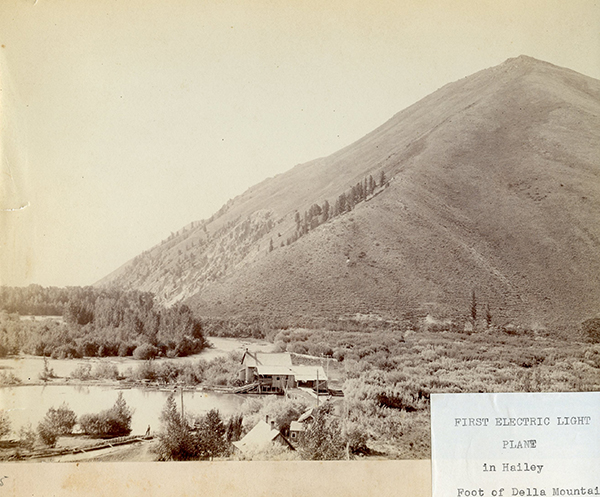
Wood River Valley was becoming known as one of the most progressive regions within the Territory
BY KAREN CROWSON

Tucked away in the Wood River Valley, the City of Hailey had been founded in 1881, during a time when electricity was making its debut throughout the 1880s and 1890s, which began changing the layout of society, just as today’s smartphones have greatly impacted our society.
Prior to the 1880s, entrepreneurs and investors alike, throughout the Midwest, were able to harness the power generated from the creeks, streams, and rivers to turn water turbines and power electric generators.
All across the nation, cities were being wired for street cars and electrical lights and local city officials as well as business executives in the West began examining the potential electric power of the regions’ canals, rivers, and streams, and in 1882 The Philadelphia Mining and Smelting Company installed the first electrical light plant in the Idaho Territory near Ketchum.
By 1883, Idaho’s first commercial telephone system was installed in Hailey on October 1, and on May 20, 1887, the new electric light system was completed and activated. A waterwheel on the Big Wood River was installed and Hailey became the first municipality to produce electricity in the Idaho Territory and the Wood River Valley was becoming known as one of the most progressive regions within the Territory.
Water was diverted from the Big Wood River to the Trail Race Canal and began generating electricity, supplying 214 lamps in operation that evening. The cost for an all-night lamp was .10 cents per night, while 12 o’clock lamps were eight cents per day. The following day, 50 orders for lamps were put in and plans to install arc lights for street illumination began.
The site of the Idaho Electric Supply Company was on the southeast corner of Croy and Main Street, while electricity was generated at the end of West Silver Street at West Coast Power. The Swan Lamp and Brush Dynamo was used with a 38-horsepower capacity and a maximum of 350 lamps.
After the City of Hailey received electricity, Boise was next and on July 4, 1887, Boise received electricity.
The Statesman recorded, “Improvements come a little slow sometimes, but Boise ‘gets there’ in good shape and good time.”
In 1888, the West Coast Power building was destroyed by fire and in 1889 Ervin W. Johnson became manager of the Hailey Electric Light Works. Johnson also managed the Rocky Mountain Bell Telephone Company and had served as postmaster of Bellevue from 1883–1885. Prior to managing the HELW, Johnson had married Miss Louise Crane in 1888 and had been the proprietor of the Alturas Hotel in Hailey.
By March of 1890, Hailey supplied 500 lamps and the local paper reported, “The electric and telephone companies are having considerable trouble with their wires and poles, the softening of the ground, causing many poles to incline from the perpendicular, disarranging the wires and not infrequently breaking them.”
In 1894, Johnson left both the HELW and RMBTC. Johnson had been connected with the Modern Woodmen of the World, the Benevolent Protective Order of Elks and the Knights of Pythias.
On April 4, 1900, the publication Electricity wrote of Hailey, “The water power of the Wood River is to be utilized to build an electric light plant here this spring.”
On July 26, 1913, the Journal of Electricity, Power and Gas recorded, “Harry J. Allen recently returned from Chicago where it is reported he completed arrangements for the construction of an electric light plant in Hailey. The Beaver Falls Light and Power Company has promised to extend their lines to the town of Hailey, but so far have not done so, and this proposed plant is being considered on account of the failure of the Beaver Falls Company to supply service to the town.”
On February 21, 1914, the publication Electrical World wrote, “The Hailey Electric Company has been incorporated by Fred W. Gooding of Shoshone, Frank R. Gooding of Gooding, and John R. Hart of Hailey. The company is capitalized at $45,000 and will take over what was formerly known as the Cramer Light and Power system.”
1916 is the year known for the formation of the Wood River Power Company, which took over both properties and businesses of the Hailey Electric Company in Hailey and the Rockwell-White Power Company in Bellevue.
On February 26, 1916, the Electrical Review and Western Electrician wrote, “Mr. John R. Hart has resigned as general manager of the Hailey (Idaho) Electric Company and has been succeeded by Mr. E.W. Rising, formerly connected with the Great Shoshone and Twin Falls Power Company of Twin Falls, Idaho.”
During 1916, the WRPC was incorporated with a capital of 2,750 shares at $100 each and was incorporated by E.R. Rising, I.E. Rockwell, and L.R.W. Rockwell.
The WRPC served the communities of Carey, Picabo, Gannett, Ketchum, Hailey, Bellevue, and other surrounding areas without competition as well as owning two hydroelectric plants in Hailey and Bellevue. The total installed capacity of these plants were 1,000 kw with the transmission system connected to the Idaho Power Company in Shoshone.
The WRPC, with its office located in Hailey, had E.W. Rising as general manager, L.R.W. Rockwell as treasurer, Hazel George as secretary, J.J. Donovan as vice president, and I.E. Rockwell as president. Serving as directors were I.E. Rockwell, L.R. Rockwell, J.J. Donovan, Hazel George, and B.W. Oppenheim.
On November 20, Volume 69 of the Electrical Review and Western Electrician recorded, “Hailey, Idaho — The Idaho Exploration Company is planning the erection of a power plant to serve its Black Barb mines in the Kelly Gulch section.”
By 1920, a report was released by the Public Utilities Commission of the State of Idaho, stating, “The two companies which were the predecessors of the Wood River Power Company had a rather difficult financial history, which resulted in receiverships and a considerable loss to the investors. The work of promoting and organizing the new company occupied approximately five years, and required almost constant work on the part of those responsible for the new organization. At the time the new company was formed and the properties of the old companies taken over by it, these properties were serving two separate and relatively small districts. They were without financial power either to render satisfactory service to the districts in which they were operating or to extend to other districts which needed service.”
The report continued, “The work of reorganization was done principally by Irvin E. Rockwell, president of the Wood River Power Company, and those associated with him, and was without remuneration.”
Elaine Myers, resident of Bagdad, Arizona, and a 1963 Hailey High School graduate born in 1945, says, “I can remember when the poles were put up on Glendale Road. It was so exciting to flip a switch and have light instead of a kerosene lamp. We also drilled a well 500 feet to get water into the kitchen… didn’t have a real bathroom until about 1950. It was so wonderful not to have to go to the outhouse! Lead pipes and all. Frank Scharff was the only plumber in the valley! Took many a bath in a galvanized wash tub in the middle of the kitchen floor. Idaho Power was our provider.”
Myers says she was raised on the first ranch after crossing the Wood River on Glendale Road where her father, Bill raised cattle and sheep. Myers’ grandfather, Arthur Cloughton, had immigrated from Yorkshire, England, and homesteaded on Rock Creek west of Hailey, raising sheep and cattle.
“It is subdivided now (Glendale Road) into a nursery and businesses,” says Myers. “My sister Thelma is married to Les Cameron and they live on what is left of the ranch now.”
Born in Bellevue in 1940, Elizabeth Patterson says, “I remember having electric power but it was one light hanging down from the ceiling, which was turned on with a string hanging from a little chain. We had one pipe bringing running water in the kitchen sink, but no indoor bathroom.”
By 1962, the Hailey-Ketchum transmission line was installed from Hagerman at the Idaho Power King substation to Ketchum at the Wood River substation via the Hailey transmission station and is 59 miles long, crossing 28.5 miles of public land managed by the Bureau of Land Management and is one of two lines serving the Wood River Valley. First operating at 46 kv, the 12.4-mile-long line from Hailey to Elkhorn and to Ketchum was later raised to 138 kv. Both of these lines were constructed with wooden frame structures.
In 1973, Idaho Power was granted a Certificate of Public Convenience and Necessity to construct a 50MW oil-and-gas -ueled generator in Hailey as well as a redundant transmission line from Hailey to Ketchum, but in 1995 Idaho Power requested the Public Utilities Commission withdraw the CPCN, stating the redundant line wasn’t needed. The PUC withdrew the CPCN due to Idaho Power’s findings of only three minutes of unplanned outages since 1980, showing the existing line to be reliable.
Outage records for the first 18 years of operation (1962–1980) cannot be provided, but from 1995–2017 only 10 outages were reported for the Hailey-Ketchum transmission line.
By 2016, Idaho Power stated a $34 million rebuild of the aging line was necessary due to an inadequate and older conductor (wires) as well as announcing plans in installing a second line from the Wood River substation to Ketchum, serving as a redundant line and helping to minimize risks of outages as well as providing reliable service.
The Department of Environmental Agency stated there were 14 sage grouse leks within two miles of the Hailey-Ketchum line, but the BLM reported disturbance to grouse would be avoided as Idaho Power would conduct its activities in the area outside of lekking season.
In November of 2017, after having completed the southern portion of the line through Gooding and Camas counties, the northern portion in Blaine County was completed as well. The new line was created with steel structures compared to the wooden structures of the original line as well as larger wires.
